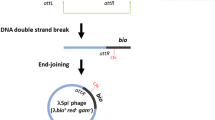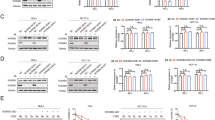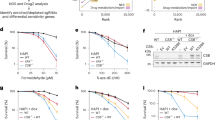Abstract
The Escherichia coli single-stranded DNA binding protein (SSB) is implicated in DNA replication, recombination and repair1. On the chromosome, the ssb gene is located adjacent to the excision repair gene uvrA, but the two genes are transcribed in opposite directions2. uvrA has been shown to be part of the E. coli SOS system by introducing Mud(Ap, lac) insertions distal to the regulatory region of the gene in the chromosome3. Recent investigations suggest that SSB is also involved in the SOS response1,4,5. However, because the SSB protein is essential to the cell, the inducibility of the ssb gene cannot be investigated by the insertion method. Therefore, we used plas-mids harbouring the regulatory region of ssb fused to the galK structural gene, while leaving an intact ssb gene in the chromosome. We show here that expression of the ssb gene is dependent on two promoters of which one is damage inducible. Evidence is presented that the divergently transcribed ssb and uvrA genes are controlled by a common LexA binding site.
This is a preview of subscription content, access via your institution
Access options
Subscribe to this journal
Receive 51 print issues and online access
$199.00 per year
only $3.90 per issue
Buy this article
- Purchase on SpringerLink
- Instant access to full article PDF
Prices may be subject to local taxes which are calculated during checkout
Similar content being viewed by others
References
Glassberg, J., Meyer, R. & Kornberg, A. J. Bact. 140, 14–19 (1979).
Sancar, A., Williams, K. R., Chase, J. W. & Rupp, W. D. Proc. natn. Acad. Sci. U.S.A. 78, 4274–4278 (1981).
Kenyon, C. J. & Walker, G. C. Proc. natn. Acad. Sci. U.S.A. 77, 2819–2823 (1980).
Lieberman, H. B. & Witkin, E. M. Molec. gen. Genet. 183, 348–355 (1981).
Whittier, R. F. & Chase, J. W. Molec. gen. Genet. 183, 341–347 (1981).
Backendorf, C., Brandsma, J. A., Kartasova, T. & Van de Putte, P. Nucleic Acids Res. (in the press).
Sancar, A., Sancar, G. B., Rupp, W. D., Little, J. W. & Mount, D. W. Nature 298, 96–98 (1982).
Wickner, S. H. A. Rev. Biochem. 47, 1163–1191 (1978).
Little, J. W. & Mount, D. W. Cell 29, 11–22 (1982).
Brandsma, J. A., Stoorvogel, J., Van Sluis, C. A. & Van de Putte, P. Gene 18, 77–85 (1982).
Meyer, R. R., Voegele, D. W., Ruben, S. M., Rein, D. C. & Trela, J. M. Mutat. Res. 94, 299–313 (1982).
Reed, R. R., Shibuya, G. I. & Steitz, J. A. Nature 300, 381–383 (1982).
Salles, B., Paoletti, C. & Villani, G. Molec. gen. Genet. 189, 175–177 (1983).
Bolivar, F. et al. Gene 2, 95–113 (1977).
Rosenberg, M. & Court, D. A. Rev. Genet. 13, 319–353 (1979).
Berk, A.-J. & Sharp, P. A. Cell 12, 721–732 (1977).
Author information
Authors and Affiliations
Rights and permissions
About this article
Cite this article
Brandsma, J., Bosch, D., Backendorf, C. et al. A common regulatory region shared by divergently transcribed genes of the Escherichia coli SOS system. Nature 305, 243–245 (1983). https://doi.org/10.1038/305243a0
Received:
Accepted:
Issue date:
DOI: https://doi.org/10.1038/305243a0
This article is cited by
-
The stringent response regulator (p) ppGpp mediates virulence gene expression and survival in Erwinia amylovora
BMC Genomics (2020)
-
Characterization of two naturally truncated, Ssb-like proteins from the nitrogen-fixing cyanobacterium, Anabaena sp. PCC7120
Photosynthesis Research (2013)
-
Transcriptional interaction between the promoters of the maize chloroplast genes which encode the β subunit of ATP synthase and the large subunit of ribulose 1,5-bisphosphate carboxylase
Molecular and General Genetics MGG (1989)
-
Reduced transcription of the rnh gene in Escherichia coli mutants expressing the SOS regulon constitutively
Molecular and General Genetics MGG (1987)
-
The relative rate of synthesis and levels of single-stranded DNA binding protein during induction of SOS repair in Escherichia coli
Molecular and General Genetics MGG (1987)



